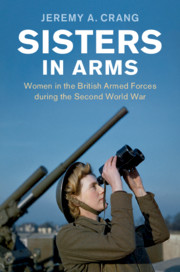Book contents
- Sisters in Arms
- Studies in the Social and Cultural History of Modern Warfare
- Sisters in Arms
- Copyright page
- Dedication
- Contents
- Figures
- Acknowledgements
- Prologue
- 1 Revival
- 2 Organisation and Recruitment
- 3 Training and Selection
- 4 Work
- 5 Status and Discipline
- 6 Necessities of Life
- 7 Medical Matters
- 8 Off Duty
- 9 Overseas Service
- 10 Demobilisation and the Creation of the Permanent Women’s Services
- Conclusion
- Notes
- Appendix
- Bibliography
- Index
5 - Status and Discipline
Published online by Cambridge University Press: 31 August 2020
- Sisters in Arms
- Studies in the Social and Cultural History of Modern Warfare
- Sisters in Arms
- Copyright page
- Dedication
- Contents
- Figures
- Acknowledgements
- Prologue
- 1 Revival
- 2 Organisation and Recruitment
- 3 Training and Selection
- 4 Work
- 5 Status and Discipline
- 6 Necessities of Life
- 7 Medical Matters
- 8 Off Duty
- 9 Overseas Service
- 10 Demobilisation and the Creation of the Permanent Women’s Services
- Conclusion
- Notes
- Appendix
- Bibliography
- Index
Summary
At the start of the war, members of the ATS, WAAF and WRNS were technically civilians and not subject to the full panoply of military law as incorporated in the Army Act, Air Force Act, and the Naval Discipline Act. This chapter describes how the ATS and WAAF were given military status and sections of the Army and Air Force Acts were applied to these forces. The WRNS, however, was excluded from this process of militarisation and was not brought under the Naval Discipline Act.
- Type
- Chapter
- Information
- Sisters in ArmsWomen in the British Armed Forces during the Second World War, pp. 93 - 111Publisher: Cambridge University PressPrint publication year: 2020

